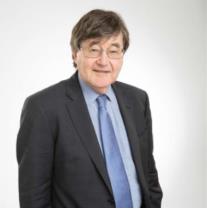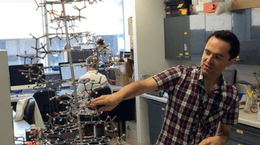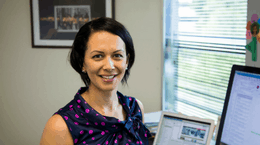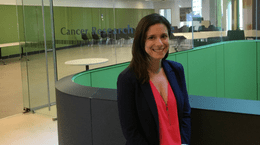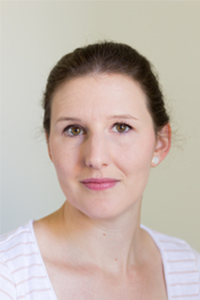You have returned to the top of the page.
This year breast cancer became the most commonly diagnosed cancer in Australia. Although it has one of the highest survival rates, thanks largely to research, 10 per cent of those diagnosed with breast cancer still die from the disease within five years. NBCF has commissioned an Australian-first research project to better understand and predict who makes up that 10 per cent.
Professor David Roder, Chair of Cancer Epidemiology and Population Health at the University of Adelaide will undertake a project that will provide valuable information on pockets of risk among the breast cancer population.
This information will allow a substantial leap forward in understanding which women have worse health outcomes compared to others, the detailed reasons for the disparity and what that means for the women affected. NBCF will use the information to make data-driven decisions in setting research priority areas for breast cancer research funding. It will also provide a platform for NBCF to advocate changes in public health policy and service delivery that could help close the gap and stop deaths from breast cancer.
Breast and prostate cancers although located in different parts of the body and in different genders, are actually fairly similar in that they are both driven by abnormally high hormone receptor activity.
Surgery and radiation therapy can effectively treat these cancers when the tumour in the early stage, when it is confined within the organ of origin.
However, for cancers that have spread out of the breast or prostate, the major treatment strategy is to completely abolish the activity of the offending hormone receptor so it cannot take in the hormones needed for growth. This treatment strategy is called hormone deprivation therapy and has been used for the past century.
For some people with breast or prostate cancer, this therapy can be effective for years, but often the side effects are debilitating and patients feel miserable. For others, this therapy does not work at the outset or their cancer rapidly becomes resistant.
It is these highly aggressive therapy-resistant tumours that kill people with breast or prostate cancer, a problem which has no yet been overcome.
To make significant progress towards curing these two diseases and improving quality of life, a new way of thinking about treatment is required.
NBCF has funded Professor Wayne Tilley and his team of national and international collaborators to investigate a ground-breaking new treatment strategy that aims to rehabilitate rather than abolish the offending hormone receptors that drive breast and prostate cancer – returning them to their normal state that doesn’t promote tumour growth.
Importantly, Professor Tilley aims to repurpose existing approved drugs which will vastly increase the speed of translating findings from the laboratory to the clinic and benefit patients.
Our exciting preliminary research indicates that this approach will increase the lifespan of patients with therapy-resistant breast or prostate cancer, as well as improving their quality of life by reducing side effects.
Approximately 10 per cent of breast cancer cases are caused by faulty genes being handed down through generations. Those with familial breast cancer genes have a higher risk of developing the disease, are likely to get it at an earlier age and have a lower rate of survival than others with breast cancer.
BRCA1 and BRCA2 are well-known genes associated with a family history of breast cancer, but they don’t tell the full story – in about 50 per cent of families with a strong family history of breast cancer, the responsible gene is not known.
The advent of genetic testing for genes associated with breast cancer has contributed to prevention and early diagnosis. There is room for improvement however as most of these tests are limited to looking for BRCA1 and BRCA2 genes, leaving many families with little information about their risk.
Attention is turning to two other genes, FANCC and FANCM, which evidence suggests could also be involved in familial breast cancer.
This study aims to determine the prevalence of FANCC and FANCM by analysing a large number of Australian familial breast cancer cases, and unaffected women, to see if adding these genes to standard genetic tests would be beneficial.
For women and men who have breast cancer in the family but test negative for BRCA1 and BRCA2, knowledge of other genes associated with a high risk of breast cancer is valuable information that can help them make informed choices about potential preventative measures that could mean they never develop breast cancer.
This national collaborative study led by Dr Andrew Deans will also aim to see if mutations in FANCC and FANCM follow a mechanism similar to that of mutated BRCA1 and BRCA2 genes in being unable to properly repair damaged DNA.
This could provide a better understanding of other genes that may also be associated to breast cancer, and point to opportunities for improving treatments for these families.
When breast cancer spreads to other parts of the body (a process called metastasis), cancer cells break away from the main tumour and move through the blood stream – the DNA from these tumour cells then appears in the blood and is called circulating tumour DNA, or ctDNA.
Researchers believe that analysing ctDNA could lead to the ability to predict, detect and monitor the return and spread of breast cancer.
In this project, Louisa Lo will use advanced technology to read the genetic code of genes (gene sequencing) originally found within tumour cells and identify those that have undergone changes, mutated. She aims to find a biomarker for the most common type of breast cancer, estrogen receptor positive (ER+) breast cancer, of which around 30 percent will become metastatic at some point.
The advantage of analysing the ctDNA contained in a blood sample is that it contains information about all the genetic mutations that may occur at different metastatic sites in the body, information that can be missed by traditional tissue biopsies.
This will allow Louisa Lo means to map all of the gene mutations that occur in ER+ metastatic breast cancer, something which hasn’t been done before. This type of information may help classify patients so they can receive more personalised treatment in the future.
ctDNA may also be used to monitor how patients are responding to treatment, and this project will follow groups of patients receiving standard and targeted treatments to compare the results. This study could also provide insights into how resistance to treatment for metastatic breast cancer develops at the genetic level.
Research in this area is very promising if successful would be a major breakthrough in understanding what breast cancer is doing at any given time – information that will be welcome for patients who live in fear of their cancer returning and could provide doctors with another tool to help them save lives.
Almost 1,500 Australian women are diagnosed with metastatic breast cancer each year, an advanced stage of the disease where the tumour has spread beyond the breast to other organs.
These women face not only a terminal illness, but also deal with poor quality of life and physical health as a result of the disease progressing and the side effects of their cancer treatments.
Although treatments are not yet curative for metastatic breast cancer, they are designed to prolong life so women may endure this stage of the disease in a state of discomfort for many years.
Previous studies in women with early stage of breast cancer have shown that physical activity and a healthy, well-balanced diet are beneficial for these women.
It is also believed that physical activity would help improve the quality of life and wellbeing of women with metastatic breast cancer. However, there have been few studies in this area and there are no guidelines for the best diet and activity that would take into account each woman’s situation and specific needs.
The aim of this pilot study is to determine the viability of an exercise and diet program for women with metastatic breast cancer, and to test whether the program improves women’s quality of life, wellbeing and physical health.
During the program, participating women will be encouraged to focus on increasing both aerobic-based and resistance-based exercise sessions during personal training sessions tailored to their level of ability and existing fitness.
A dietitian will work closely with women throughout the program to help improve their diet quality. The advice will be tailored to each woman and consider any side-effects they may experience from their treatments, such as nausea/vomiting or constipation/diarrhoea.
This will be the first trial to evaluate an exercise and dietary intervention in this population, and provide much-needed evidence-based knowledge to help improve the quality of life for these women.
Findings from this study will then inform a larger research study and could ultimately inform public health guidelines and support for women with metastatic breast cancer, forming part of their routine cancer care in the future.
Genetic testing has come a long way helping to identify women with a high risk of breast cancer due to family inheritance, particularly the BRCA1 and BRCA2 genes.
However, many of the women who attend familial cancer clinics due to a family history of breast cancer, and have a genetic test, receive results that are not informative. That is, no mistakes in those genes are identified to explain their personal and/or family history of breast cancer.
But that doesn’t mean that these women are not at increased risk of developing breast cancer. This study will investigate how best to provide women with information about their polygenic risk of breast cancer.
For women at familial cancer clinics who received uninformative results from standard genetic testing, polygenic information helps categorise them as low, medium or high risk, opening the door to more personalised risk management strategies.
This could also lead to dramatic changes to current population screening for breast cancer, meaning women without a family history of breast cancer could use polygenic testing to personalise their routine mammographic screening.
Finally, findings from this study could also benefit other diseases, such as cardiovascular disease and diabetes, providing a model for similar research across other important fields in medicine.
This is the world’s first study to assess the psychological and behavioural impact of offering women information on their polygenic risk of breast cancer. The results will help ensure polygenic risk testing and counselling are included in clinical practice.
Most people have heard of the double helix – a 2-stranded DNA sequence which is the master code for our bodies to function properly. Recently scientists discovered that humans also have some 4-stranded DNA sequences, called G4-DNA. G4-DNA is most often found in our genes – part of our DNA which directs how cells function. Scientists believe G4-DNA formation can control whether a gene is turned on or off, hence acting like a “switchâ€. Cancers occur and grow when certain “switches†in our genes are abnormally turned on or off allowing the cell to grow and spread in an abnormal way and thus become a cancer.
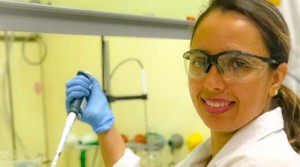
Dr Nicole Smith
Dr Nicole Smith has found that the G4-DNA in breast cancer has been altered and she has been funded by NBCF to further investigate the mechanism for that alteration and determine if it can be ‘undone’, stopping growth and destroying breast cancer cells.
This new understanding in breast cancer – seeking to turn on and off the DNA that controls the genes involved in cancer development – could be a more direct approach to stopping cancer than targeting specific proteins or enzymes on the cancer itself because the genes are ultimately easier to precisely target with therapies.
More than 15,000 women in Australia were diagnosed with breast cancer in 2015. For more than 13,000 of them radiotherapy is recommended, while recent large cohort studies raised concerns about increased risks for cardiac diseases of between 7-20% resulting from radiotherapy to the left breast compared to the right breast. For patients, who were diagnosed when <50 years old (more than 20% of the new cases), the risks for cardiovascular diseases/events from radiotherapy to the left breast were increased by 24-82%.
As a result, the deep inspiration breath hold (DIBH) technique aims to minimise the heart dose and subsequently reduce the damage. Patients are asked to repeatedly hold their breath for 20 seconds at a time during radiotherapy, thus moving their hearts out of the radiation beams. Giving patients visual feedback of their breathing via a screen has demonstrated to improve the breath hold reproducibility and stability. To date only half of the Australian clinics have implemented DIBH treatments and 30% of them provide the patients with an in-house jerry-rigged feedback screen as there is no commercial product available. Within the pilot study BRAVEHeart (Breast Radiotherapy Audio Visual Enhancement for sparing the Heart) the new, easy to use system ‘Breathe Well’ is being developed and will be benchmarked against a commercially available solution with in-house modifications for a visual patient feedback. ‘Breathe Well’ aims to empower all Australian breast cancer patients to save their hearts using an automated, efficient, accurate and patient-friendly visual breath hold guidance.
Women with a mutation in the BRCA1 gene have a high lifetime risk of developing breast (and ovarian) cancer, often at an early age. While regular screening can detect breast cancer at an early stage, this does not by itself prevent cancer.
Although mastectomy (breast removal) can be highly effective at preventing breast cancer, most women choose not to pursue this surgical option. Apart from a mastectomy, currently available prevention strategies for BRCA1 mutation carriers include taking the drug tamoxifen and/or removal of the ovaries (the latter primarily to reduce ovarian cancer risk).
There is good evidence that tamoxifen reduces the incidence of estrogen receptor (ER) positive tumours, but its role in BRCA1 mutation carriers is unclear. Moreover, there has been poor uptake of tamoxifen as a preventative treatment for breast cancer, even when prescribed by clinicians. For this reason a suitable prevention therapy is needed that is both safe and effective, so that women with a BRCA1 mutation never face breast cancer.

Professor Geoff Lindeman
Professor Geoff Lindeman and his team recently identified a protein, called RANKL, as a potential target for breast cancer prevention for BRCA1 mutation carriers (and possibly other high-risk women). A currently available inhibitor of RANKL, called denosumab, is used to treat osteoporosis and breast cancer spread to bone. Professor Lindeman believes denosumab has potential to be ‘repurposed’ as a prevention agent for breast cancer.
In this NBCF-funded study he will compare the relative effectiveness of tamoxifen, removal of the ovaries and RANKL inhibition in mice, and also determine whether RANKL has any relevance to BRCA1-associated ovarian cancer.
These findings will provide pilot data to support an international clinical trial aimed at preventing breast cancer in women at high genetic risk for developing breast cancer with the long-term goal of improving the lives of BRCA1 mutation carriers and their families.
The main cause of death from breast cancer is when it spreads to other parts of the body such as the brain, bones and liver. This metastatic stage of the disease can be treated to prolong life, but as yet no treatments are curative.
An exciting emerging area of research called immunotherapy may have the answer. Immunotherapy works by making the cancer visible to the body’s immune system so it can seek out and destroy cancer cells. Promising results have already been seen in metastatic melanoma, however to date immunotherapies have had limited success treating breast cancer patients.
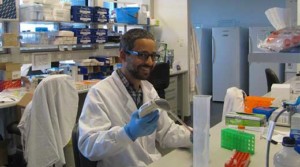
Dr Simon Junankar
NBCF-funded Dr Simon Junankar and his team are seeking to understand the one of the fundamental questions in cancer – how cancer cells avoid detection by the body’s immune system. They believe this knowledge could provide an explanation for why immunotherapy for breast cancer is not yet successful.
The researchers will use a cutting-edge DNA barcoding technique that tracks individual cancer cells through the body to the organ in which they settle. They are looking to see if the cancer cell will create a metastatic tumour, how the cancer cells respond to immunotherapy, and specifically if they are resistant to immunotherapy.
This DNA barcoding technique can determine if the cancer cells were resistant to therapy from the beginning or if the therapy prompts the development of resistance. This information will help determine the best combinations of immunotherapies for effectively treating metastatic breast cancer and eliminating cancer cells from the body.
Activating the patient’s own immune system early could ultimately prevent metastatic disease developing, dramatically reducing deaths from breast cancer.
The study is focused on two common subtypes of breast cancer which means the findings will be applicable to the majority of breast cancer patients. If successful, the study paves the way for breast cancer immunotherapy clinical trials in the not too distant future.
